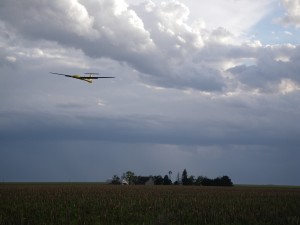
Laura Delgado Lopez
Project Manager
Secure World Foundation
Washington, D.C.
www.swfound.org
Early last year, the group on earth observations (GEO) renewed its 10-year mandate as ministers from all over the world signed a declaration under the theme of “Integrating Observations to Sustain our Planet.” The renewed mandate was one of the landmarks in multi-lateral efforts to advance global access to and use of Earth observation data in 2014.
While multilateral efforts such as GEO, the Committee on Earth Observation Satellites (CEOS), and the World Meteorological Organization (WMO) continue expanding to meet global needs, progress is also being made at a smaller scale. Efforts such as AfriGEOSS, involving 23 countries in the African region, and the U.S. decision to release global high-resolution elevation data from the Shuttle Radar Topography Mission-2 (SRTM-2), are good examples of how regional and unilateral actions can help improve access to EO data.
This article focuses on the value of bilateral partnerships in Earth observation, a unique mode of international cooperation. Collaboration between two countries may involve data exchange, expert collaboration in the processing, analysis, and use of such data, and the joint development of spacecraft and programs. This article will discuss recent developments in two long-standing bilateral partnerships: the United States and India, and China and Brazil. It will conclude by describing key policy and legal issues that arise during bilateral relationships, as examined in a recent Earth observation data sharing workshop held in Washington, D.C.
NISAR: ANOTHER MILESTONE IN U.S.– INDIA COLLABORATION
An agreement to proceed with an innovative dual frequency radar satellite – the NASA-ISRO Synthetic Aperture Radar (NISAR) – is one of the highlights of the 2014 U.S.-India bilateral exchanges. The mission, slated for launch in 2020, will enable a detailed study of land surface changes, thereby improving our understanding of the effects of complex Earth processes, climate change impacts, and natural hazards. According to the September 2014 agreement, NASA will provide the mission’s L-band synthetic aperture radar (SAR) instrument and other hardware, while ISRO will provide an S-band SAR, the spacecraft bus, the launch vehicle, and associated launch services.
NASA’s relationship with India began in the 1960s. The establishment of a Landsat receiving station in India in the late 1970s is one of the early space-based EO cooperative efforts between the partners, paving the way for activities that would include data sharing agreements, and scientific and technical collaboration in applications such as agriculture, disaster management, weather, and climate.
According to Ashok Maharaj in NASA in the World (2013; Palgrave Macmillan), the use of revolutionary Landsat images in the 1970s for natural resource management motivated the institutionalization of remote sensing in India. Moreover, NASA’s efforts to promote this new field, which included scientific and technical collaboration, contributed to the development of the first satellite in the Indian Remote Sensing (IRS) system. The Embassy of India in Washington, D.C. cites the long-standing relationship as key in enabling India to gain experience in the reception, processing and application of remote sensing data, contributing in the development by India of what is today the world’s largest constellation of civil Earth observation satellites.
The U.S. State Department describes this relationship with India as “productive cooperation” that is “vital in achieving a broad range of shared goals.” For example, under the terms of a data sharing agreement signed in 2008, ocean surface wind measurements from India’s Oceansat-2 satellite were used extensively as data inputs to hurricane models during Hurricane Sandy, which struck the east coast of the United States in 2012, leading to over $60 billion in damages.
“The signing of these two documents reflects the strong commitment NASA and ISRO have to advancing science and improving life on Earth,” said NASA Administrator Charles Bolden of the 2014 agreements. According to NASA, the partnership has been important to many of the mission’s science objectives developed in response to the priorities identified in the U.S. National Research Council’s 2007 Earth science decadal survey.
CBERS: THE SYMBOL OF CHINA–BRAZIL SPACE COOPERATION
In December 2014, China and Brazil celebrated the launch of CBERS-4, the fifth in a series of multispectral imaging satellites from the China-Brazil Earth Resources Satellite (CBERS) system. The success was especially welcome as it followed a failed launch attempt of the Chinese Long March 4B in 2013 that destroyed the CBERS-3 satellite. That loss prompted the partners to speed up development of CBERS-4, meeting yet another challenge that the partners of this decades-long collaboration have taken in stride.

FIGURE 2.
CBERS-2 image of Fortaleza, the fifth most populous city in Brazil and capital of the state of Ceará, captured in March 2004. Credit: CBERS/ INPE.
The CBERS program began with a 1988 technical cooperation agreement between Brazil’s Institute of Space Research (INPE) and the Chinese Academy of Space Technology (CAST). The goal was to enable an indigenous source of multi-spectral optical data to help manage the countries’ vast natural resources. The development of the system allowed the partners to achieve data independence and transformed them into data providers, so that they were no longer reliant on foreign sources of satellite imagery. According to INPE, this has allowed Brazil to “consolidate an important autonomy” in remote sensing.
The China-Brazil partnership is rooted in joint development and technology transfer, as a way to meet national observational goals while advancing the development of the space programs on both sides. The relationship has helped advance Brazil’s know-how in satellite development to the point that half of the components of the CBERS-4 satellite are of Brazilian origin. The new satellite represents an evolution from the first-generation systems with improved spatial and temporal resolution, and added capability, such as a new panchromatic and multispectral camera with the capability for stereoscopy.
The program has been credited with contributing to the technological, social, and economic development of both partners. “The continuity of the CBERS program is viewed as strategic for the environmental monitoring of both countries,” wrote José Carlos Epiphano, then coordinator of the CBERS application program at INPE in a 2008 Imaging Notes article. Thousands of users in Brazil and China use CBERS images for numerous monitoring, planning, and natural resource management applications. Of note is the role of the system in Brazil’s Amazon deforestation monitoring program, DETER, part of improved monitoring and law enforcement programs that contributed to a dramatic reduction in the rate of deforestation in the 2000s.
CBERS has also achieved several political goals. The first satellite cooperative program involving two developing countries, its success has been showcased as an example of South-South cooperation and as a way to defeat perceived obstacles to developing countries’ access to high technology. Writing in a 1997 article in Space Policy, José Monserrat Filho, now head of international relations at the Brazilian space agency, noted Brazil had “the strategic conviction that cooperation with China in remote sensing based on strong mutual interests could open new opportunities to acquire space technologies otherwise impossible to establish or buy for a developing country.” The continuation of the program was similarly consistent with goals described in a 2008 Chinese Policy Paper on Latin America and the Caribbean to build strategic partnerships in the region for mutual benefit and common development.

FIGURE 3.
Satellite product provided by USGS to China through the International Charter: Space & Major Disasters, in the aftermath of the 2008 earthquake in Wenchuan. Credit: K. Hudnut, USGS.
CBERS is also one of the first programs to adopt a free-of-charge distribution policy that has been extended to users all over the world. Through programs such as CBERS Africa, which involved installing receiving stations throughout the region, the partners have advanced data democracy goals, facilitating open access to CBERS data to other developing countries. In 2014, the partners announced plans to develop CBERS-4A to be launched in 2017. In the context of the development of the next 10-year cooperation plan, China and Brazil are also considering two more CBERS satellites, as well as joint development of meteorological satellites.
EXPLORING ADVANCES IN U.S.– CHINA EARTH OBSERVATION DATA SHARING
In August 2014, the U.S. National Research Council’s Board on Research Data and Information, which also serves as the U.S. Committee on Data for Science and Technology (CODATA), held a workshop with the Chinese Academy of Sciences (CAS) to examine EO data sharing and cooperation. The event was co-sponsored by the author’s employer, the Secure World Foundation (SWF), a private, operating foundation that works with stakeholders worldwide to promote space sustainability.
The workshop engaged members of the Chinese and U.S. EO communities. The goals of the event were to: identify opportunities related to data sharing; showcase recent successes and existing efforts; improve understanding of Chinese and U.S. EO data policy, programs, and issues; and identify possible follow-on activities, with a focus on data sharing for disaster management.
The highlights of the discussion point to important themes that play a role in the development of bilateral partnerships in EO.1 In particular, it was clear how interactions among government, industry, and academic partners in the collection and provision of EO data lead to legal, economic, and institutional issues that impact data sharing. In the case of China, some of the challenges that were discussed include complex relationships among central and local governments, and research communities, overlapping lines of authority, and lack of a unified set of distribution policies. In the United States, an open access policy for government sources of data is paired with copyright and other ownership restrictions that limit redistribution of certain datasets. Participants discussed different legal and regulatory mechanisms that may be adopted to balance these kinds of limitations and bring value to the partnership.
The discussion also emphasized that improved understanding of the political and institutional assets and challenges of the partners can be critical. In the United States, a current ban on bilateral cooperation with Chinese partners has been imposed on NASA and the White House Office of Science and Technology Policy. However, both sides engage regularly through bilateral and multi-lateral mechanisms. For example, the U.S. National Oceanic and Atmospheric Administration (NOAA) and the Chinese Meteorological Administration (CMA) share information on atmospheric science and technology through a bilateral protocol, and both participate regularly in platforms such as CODATA and GEO. China’s participation in GEO is one of the key drivers in the shift towards developing improved EO data sharing policies within and outside of China.
Workshop participants discussed EO data sharing for the full cycle of disaster management – from disaster mitigation through long-term recovery – as an opportunity for enhanced cooperation. Given China’s unique vulnerability to natural disasters, as well as an interest on both sides to improve understanding of hazards, exposure, and vulnerabilities to natural disasters, disaster management is a shared priority. An opportunity that participants agreed to explore is for CODATA to facilitate data sharing between China and the United States on third-party scenarios, such as natural disasters occurring in Africa.
CONCLUSION: THE BENEFITS OF A TWO-WAY CONVERSATION
Multilateral efforts often dominate discussions of international cooperation in Earth observations. While such programs advance important goals at a global level, other modes of cooperation such as bilateral partnerships co-exist to meet various scientific, technical, and political goals. Long-standing collaboration between partners such as the United States and India, or China and Brazil, indicate how experienced and emerging space nations can find value in such relationships.
Bilateral partnerships can also evolve to include other countries. The CBERS Africa program allowed direct broadcasting of CBERS data to users in Africa. Elsewhere, India’s Megha-Tropiques satellite was incorporated into the U.S. and Japan- led Global Precipitation Measurement mission.
It is important to have an accurate understanding of partners’ interests, incentives, and capabilities to determine how each would be served by the relationship. For some actors, multilateral forums remain the primary venue for developing this awareness and maintaining relationships where closer bilateral engagement may not be politically feasible.
A key element of strategic relationships between countries, bilateral partnerships can bring added value to national investments in space – based EO while also supporting political stability, thus helping improve the ability of decision makers worldwide to continue relying on these critical
information tools in the long run.
Endnote:




